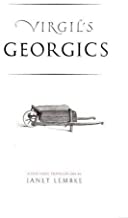Georgics by Virgil 29 BCE
The Georgics is the second of Publius Virgilius Maro (70 BCE-20BCE), known to his close friends as Virgil. This volume of 2188 hexametric verses divided into four books was published in 29 BCE, in the midst of a chaotic period of civil war in Rome that followed the assassination of Julius Caesar and the struggle between Brutus and Octavian, the future Emperor Augustus.
The poem is a long treatise on the importance and challenges of agriculture and amazingly, its advice and instructions for plowing and planting crops, grafting trees, raising livestock, and other nuts and bolts of farming remain relevant and useful 2000 years later. The references to Saturn, Jupiter, and Athena are a bit out of date, but the raising of crops and animals to feed one’s family and the community remain central concerns for humanity today as they were then.
So why read a long poem written 2000 years ago? The main reason was that the book was referenced by two books which I read last month, Donald Hall’s ‘String Too Short to be Saved’ and James Rebank’s ‘Pastoral Song’. These two books about family farms and generational continuity owe much to Virgil’s ode to farming and working the land. The second reason I picked up this book was that while managing to never learn a modern language other than my mother tongue, I did take four years of Latin in high school, under the mistaken impression that I would need Latin to write prescriptions when I finally became a doctor. Not true, but those four years with Miss Violet Zielke, who I can see in my mind’s eye as vividly as I saw her in person every day for those four years at Oak Park High Schoo,l made me a life-long devotee of the classics, especially Virgil’s ‘Aeneid’. So why not return to my high school days, pretend I’m sitting in Miss Zielke’s class, and read Virgil!
Not for everyone, but an interesting diversion from the angst of novels and the detailed information of the non-fiction out there today.



